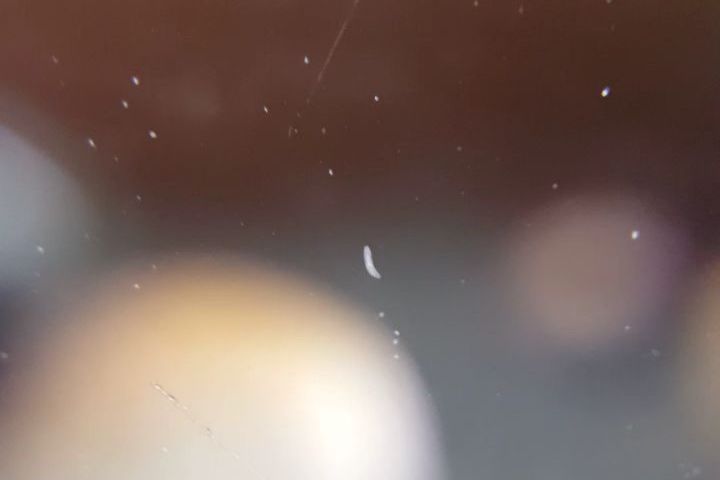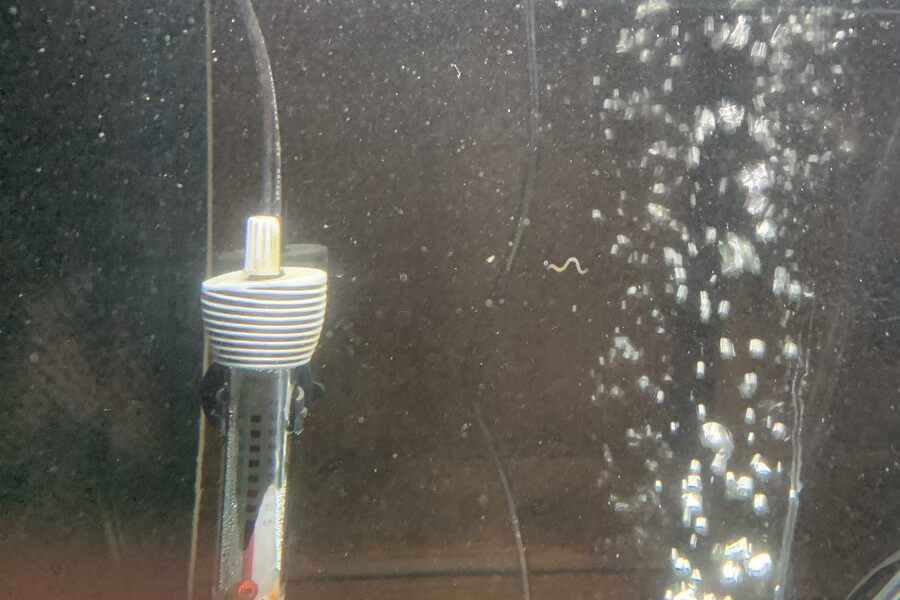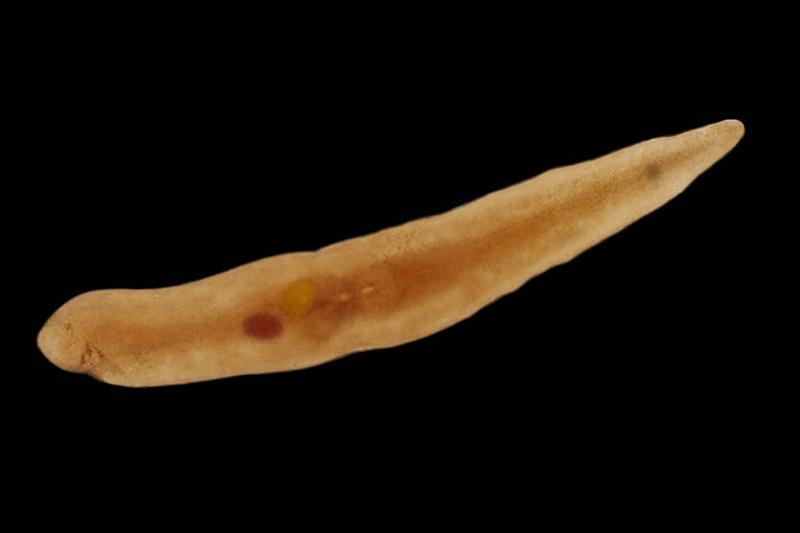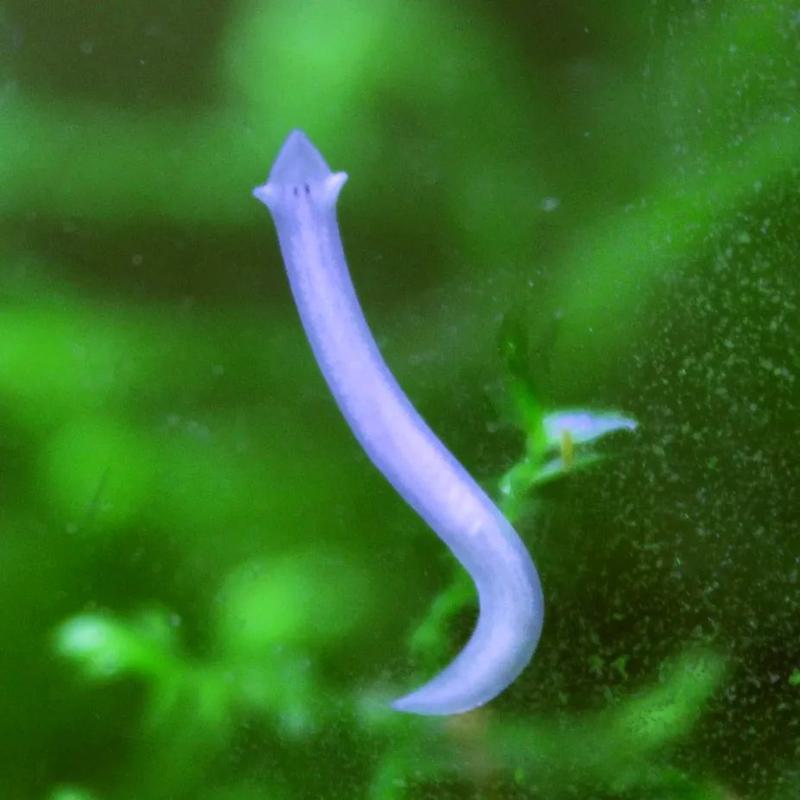Perhaps one day you noticed small white worms floating around or sitting in the substrate in your tank, but you’re unsure what to do because you don’t recognize them.
In this article, we’ll be looking at the different types of white worms you may encounter, whether they’re good for your fish, and, if not, what you can do about them.

You may encounter three types of white worms: detritus, rhabdocoela, and planaria, with planaria worms being the only ones posing a danger to your fish and being a real pest in your tank.
Remove detritus and rhabdoceala worms by reducing feeding and improving maintenance, and remove planaria worms using a deworming medication.
Now, let’s go over each of these worms in detail, including how to identify them and how to remove them from your tank.
What are Detritus Worms?

The most common type of white worm you’re most likely to encounter is the detritus worm.
Detritus worms are part of the phylum Annelida, which contains many types of segmented worms, such as leeches and earthworms.
As their name suggests, these worms feed on decaying organic matter (including animal matter, plant matter, and leftover uneaten food), otherwise known as detritus.
Even though these worms may seem unsightly at first, they’re actually quite common among aquarists, many of whom are unaware they have them in their tanks. And, though they’re not really harmful, they’re usually not something you’d like to see, especially in large numbers.
Because these worms depend on oxygen in the substrate and detritus to survive, having an overabundance of them in the water can mean that the water quality is extremely poor.
How Can You Identify Them?
Detritus worms are identified by their thin bodies, which can appear as white threads of hair floating in the water or sticking out of the substrate. These worms are relatively small, growing no longer than 0.5 inches.
Though typically white, detritus worms may also appear reddish brown/rusty or light gray.
Unlike flatworms, detritus worms are quite active and can be seen moving like earthworms while under the substrate.
If you’re ever confused, a tell-tale sign of detritus worms is the fact that they tend to float in the water. This is typically not seen in planaria worms, as they tend to glide in the water instead.
Are Detritus Worms Good or Bad for Fish?
Detritus worms, if kept at a reasonable number, can be good for fish as they are scavengers that consume dead organic matter, including leftover fish food and fish waste, thus helping to keep the water clean.
This is why some aquarists encourage having a limited number of detritus worms in their tanks, as they can provide a natural way of filtering the water of contaminants.
It’s important to note, however, that the above only applies if the worms are kept at a reasonable number.
Although detritus worms won’t directly harm you or your fish, a high abundance of them usually indicates an issue with the water quality, which can be detrimental to fish.
Having an overabundance of these worms can also potentially absorb all the oxygen from the water, leaving a minimal amount for your fish.
Therefore, while these worms are considered good for your fish in a small number, too much can certainly lead to issues down the line.
How to Remove Detritus Worms from Your Aquarium
If you have a large population of detritus worms or don’t like the thought of these small worms inhabiting your fish tank, follow these methods to ensure their removal from your tank.
Routinely Vacuum the Substrate
Use a vacuum-containing siphon system to vacuum your substrate on a regular basis. Doing this will allow you to remove fish waste, leftover food, and algae from your substrate (especially those with large particles such as gravel and limestone).
You’ll also be able to suck up most, if not all, of the detritus worms hiding within the substrate.
This way, you’ll be able to remove both the source of the problem and the problem itself in one go.
Remove Algae from the Water and Tank Sides
Another method you can try is to use ways to reduce the number of algae in your tank, hence reducing the food source of these worms and indirectly reducing their population.
Algae is quite small and won’t always sink to the substrate, hence you can try some other ways of removing it.
One way of removing algae from the water is to introduce algae eaters to the water. There are many types of freshwater animals that are considered algae eaters, including the bristlenose pleco, cherry shrimp, and trumpet snails.
Consider using a scraper or brush to remove algae from the tank walls. Simply scrub the sides of the tank using these tools while making sure no soap enters the tank.
Perform Water Changes Regularly
Water changes are essential to any tank, regardless if you have detritus worms or not because they will allow you to physically remove the majority of the waste that has accumulated in the water.
You should remove only a portion of the water to ensure the beneficial bacteria remain and that the fish don’t stress out over a significant environmental change. The exact frequency of the changes will depend on your tank and fish conditions.
Reduce the Amount of Food You Feed
The last way to get rid of detritus worms is to reduce the amount of food you feed to your fish. This is to allow less leftover food to remain in your tank and sink to the substrate.
As detritus worms feed on leftover food, by reducing the number of leftovers in your tank, you are both getting rid of the worms currently in your tank and preventing future overpopulation of the worms.
What are Rhabdocoela Worms?

A much rarer white worm you’re likely to encounter in your fish tank is the rhabdocoela worm.
Not much information is known about these worms, but it is known that they are a common flatworm belonging to the Rhabditophora class.
They are similar to detritus worms in that they are also harmless to aquatic life and can overpopulate due to the same reasons, such as an overabundance of dead organic matter in the water.
Though their names aren’t indicative of their diet, rhabdocoeala worms feed on algae, rotten plants, and leftover fish food just like detritus worms.
How Can You Identify Them?
Compared to detritus worms, rhabdocoela worms are smaller in that they’ll usually reach a maximum length of 0.2 inches. Also, these worms are flatworms that lack the segmented bodies of detritus worms.
Unlike planaria worms, another type of small white worm known to inhabit aquariums, rhabdocoela worms have bodies that consist of two round ends instead of the triangle-shaped heads seen in the former.
These worms can appear either pale or reddish-colored, depending on the genus. You’ll only be able to see the white-colored organs inside pale worms under a microscope, as it’ll be too dark to see with the red worms.
These worms are unable to swim in the water and depend on a layer of mucus to crawl around. They tend to move around slowly but fluidly (similar to a snail’s movement) but can contract under extreme circumstances.
Are Rhabdocoela Worms Good or Bad for Fish?
Similar to detritus worms, rhabdocoela worms are considered beneficial to the fish and your tank in general (in fact, they’re considered part of the natural ecosystem in the tank).
However, this is also under the assumption that you only have a modest number of them.
Like detritus worms, rhabdocoela worms are detritus feeders, hence they provide means of a natural water filter by removing all the algae, dead animal and plant matter, and leftover food from the water. This can potentially save you lots of time and trouble in having to otherwise clean the tank yourself.
With the same benefits of detritus worms also come the same downsides. If you notice an overabundance of rhabdocoela worms, it’s most likely that there’s an issue with the water.
And although these worms are normally considered harmless to fish, having too many of them can lead to competition for oxygen in the tank. This can in turn indirectly affect your fish’s health, so it’ll probably be time for you to act.
How to Remove Rhabdocoela Worms from Your Aquarium
Whether you have an overabundance of rhabdocoela worms or you simply don’t like the thought of them in your fish tank, follow these methods in order to safely remove them from the tank.
You may find that several of these methods are the same as those needed to remove detritus worms from your tank.
Vacuum the Substrate on a Regular Basis
As with detritus worms, you’ll want to vacuum your substrate using a vacuum-containing siphon system in order to remove all the dead organic matter that’s fallen and gathered in the substrate.
You’ll also be able to remove the worms from the substrate entirely. As these worms can’t swim and can really only crawl around, the majority of them should be in the substrate for you to vacuum up.
Removing Their Food Source
Like detritus worms, rhabdocoela worms feed on the detritus that’s sunken to the bottom of your tank. Hence, in order to both reduce the number of worms you have now and prevent future overpopulating, you should decrease the amount of leftover food in your tank.
You can try to change your feeding habits from a few large meals to several smaller meals a day so that you’re in better control of how much food you’re introducing to the tank. By increasing or decreasing a small meal, you’ll be able to know exactly how much food you should feed your fish.
Once there’s no more leftover food, a portion of your worms should starve out. And if leftover food is all they had to eat, then you should be able to completely eradicate them.
Introduce Predatory Fish that Feed on the Worms
Many types of fish feed on marine worms and flatworms such as Rhabdocoela. Introducing some to your tank can provide a natural way of eliminating these worms.
Some examples of well-known predatory fish include:
- Angelfish
- Goldfish
- Guppies
- Leopard wrasse (saltwater tanks)
- Yellow coris wrasse (saltwater tanks)
- Glow damsels (saltwater tanks)
- Blue damsels (saltwater tanks)
Keep in mind that some of these fish may prey on other smaller fish in your tank once the worms are gone, so remember to place them in a separate tank if needed to prevent such events from occurring.
Perform Routine Water Changes
Another method that goes well with vacuuming the substrate is to change the aquarium water on a regular basis. Each water change will allow you to remove a large number of these worms and is a more effective way of filtering out the water than constantly depending on a regular filter.
Like in the case of detritus worms, the exact amount of water to change and the frequency of the water changes will depend on your situation, but it’s recommended not to replace all the water at once.
Use Deworming Chemicals
The last method is to use chemicals that are available on the market to kill the worms in your tank. As this involves introducing potentially toxic chemicals to your fish, it’s best considered as a last resort and should only be used after you’ve confirmed how the fish will be affected.
You’ll most likely need to remove your aquatic animals from the tank before adding these chemicals, however always reach out to a veterinarian to confirm what you should do with your fish ahead of time.
What are Planaria Worms?

Now we’ve arrived at what is potentially the most troublesome small white worm you’ll encounter in your fish tank. Planaria worms are part of the class Turbellaria, which is very closely related to tapeworms and flukes, other types of parasitic flatworms.
Planaria worms are quite widespread in the wild because they’re able to survive in both saltwater and freshwater environments.
Not only that, but they’re also quite difficult to remove from your aquarium, with the main reason being that they’re able to reproduce asexually using a very efficient manner. If you try to cut a planaria worm into pieces, you’ll notice that each piece will grow into a new worm.
These worms also consume fresh food; hence they can find plenty of resources in the tank to sustain their lives.
How Can You Identify Them?
Planaria worms vary in length, with some ranging from 0.1 inches to several inches. However, the ones you’re most likely to encounter are typically smaller than detritus worms, closer to the length of a rhabdocoela worm.
Planaria worms range in color, such as white, reddish-brown (rusty colored), black, and pink. The exact color depends on what they’re currently feeding.
Unlike detritus worms, planaria worms have flattened bodies with an obvious triangular-shaped head that contains two eyespots. Their head shape allows you to easily distinguish these from detritus and rhabdocoela worms.
Are Planaria Worms Good or Bad for Fish?
Unlike the previous two white worms we’ve looked at, planaria worms are considered harmful to your fish and should not be kept in your fish tank under any conditions. There are two reasons for this.
One is that, unlike the other worms we’ve discussed, planaria worms are not detritus feeders; rather, they’re always on the lookout for a protein-based meal, including many fresh foods.
Although they’re unable to attach themselves to fast-moving fish or invertebrates, planaria worms will take a bite out of any unaware shrimp or fish the first chance they get.
Not only are planaria worms harmful to fish and other aquatic animals, they’re also particularly detrimental to breeding animals since they’re fond of juvenile fish (aka. Fish fry), baby shrimp, and eggs belonging to shrimp, snails, and fish.
How to Remove Planaria Worms from Your Aquarium
Like with previously mentioned worms, methods such as reduced feedings, gravel vacuuming, and water changes can help control planaria worm numbers, however, they won’t be able to remove them entirely from your fish tank.
The best way to fully remove them is by using a deworming medication. Examples that have been proven to work include:
- Fish Bendazole (Fenbendazole)
- API’s General Cure
- Clout
As mentioned before, using deworming medication/chemicals can result in harmful interactions with your aquatic life. Hence, it’s important that you follow any instructions provided by the product’s manufacturer, and consult your veterinarian, to ensure no harm comes to the aquatic life.
Frequent water changes are also essential as the deworming medication can produce large populations of dead planaria worms, which if left alone, can significantly raise the ammonia levels in the water.
Also Read:
FAQs
1. Which Types of Small White Worms Might You Notice on Your Fish Tank Glass?
All three of the types of worms we’ve discussed can potentially be found on your fish tank glass.
Detritus worms, when abundant, can be found crawling slowly on the aquarium glass or floating through the water.
Rhabdocoela worms also move along the glass, however, they’re more likely to glide across the glass than wiggle like detritus worms.
Planaria worms are especially fond of glass and are the most likely ones to be seen crawling across it.
Conclusion
We’ve gone through quite a bit of information on these tiny white worms, however, you may have noticed there are several similarities between them.
As long as you follow the methods we’ve listed in this article, you should have no difficulty removing whichever type of worm you happen to find.